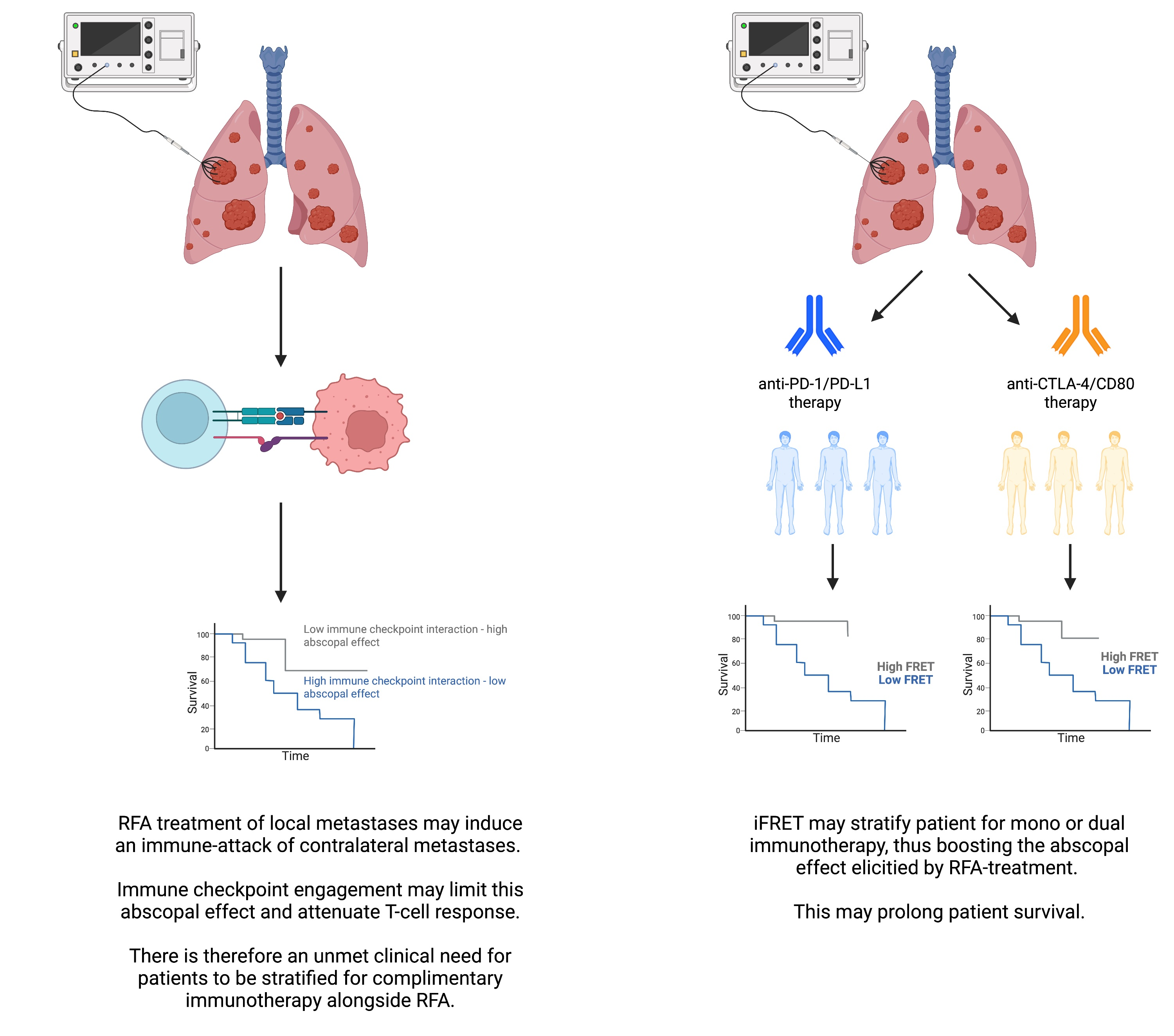CTI-Bathで共同開発された、がん患者の免疫療法への反応性を予測するイメージング・プラットフォームの有効性を示す研究です。 Research validates an imaging platform co-developed at CTI-Bath which predicts if a cancer patient would respond well to immunotherapy.
2022-11-22 バース大学
臨床医は、最適な治療を行うために、単に関連するタンパク質のレベルだけでなく、患者の中で免疫細胞と腫瘍がどのように相互作用しているかを理解する必要があるのである。
この研究結果は、CTI-Bathで使用されている定量的イメージング・プラットフォームを検証するもので、がん患者が免疫療法に反応するかどうかを予測することができる。
ラジオ波焼灼術(RFA)を用いて片方の肺の腫瘍を治療すると、もう片方の肺の腫瘍も小さくなる場合がある。この効果は、がん治療が抗腫瘍免疫反応を引き起こすためと考えられているが、免疫チェックポイント制御因子の相互作用によって制限される可能性があえう。チェックポイント調節因子とは、免疫チェックポイントを構成するタンパク質で、このタンパク質は鍵と錠のように相互作用し、調節因子タンパク質が免疫系タンパク質のターゲットに入り込んでそれを閉じ、免疫反応を低下させる。
研究チームは、共同研究者が開発したiFRET分子イメージングプラットフォームを用いて、これらの制御因子とその標的が実際にどのように相互作用しているか、すなわち「関与」レベル(つまり活性化状態)を比較した。
これは、RFA患者におけるこれらの相互作用が定量化された初めての例であり、その結果、関与は存在するタンパク質の量と相関しないことが示された。つまり、存在するタンパク質のレベルに基づく処方が適切である可能性は低いということである。
<関連情報>
- https://www.bath.ac.uk/announcements/new-study-brings-personalised-immunotherapy-prescriptions-a-step-closer/
- https://www.mdpi.com/2072-6694/14/23/5738
ラジオ波焼灼術後の肺転移巣における免疫チェックポイント制御因子の相互作用状態の決定 Determination of Interactive States of Immune Checkpoint Regulators in Lung Metastases after Radiofrequency Ablation
James Miles,Isabelle Soubeyran,Florence Marliot,Nicolas Pangon,Antoine Italiano,Carine Bellera,Stephen G. Ward,Franck Pagès,Jean Palussière and Banafshé Larijani
Cancers Published: 22 November 2022
DOI:https://doi.org/10.3390/cancers14235738

Simple Summary
Radiofrequency ablation (RFA), when used for the treatment of pulmonary metastases, results in the generation of tumor-specific neo-antigens that may prime an immune response of the remaining metastases. Under these circumstances, the immune system may become responsible for the widespread attack of the remaining neoplasia. Immune checkpoint interactions are thought to limit this response. A platform that enables the precise measurement of immune checkpoint interactions and stratifies patients for immunotherapies, alongside radiofrequency ablation, may be a potent method for enhancing response rates in patients with metastases. To determine the immune mechanism triggered by RFA, leading to this abscopal effect, we have exploited our imaging platform that quantifies the spatio-functional states of biomarkers rather than their expression level. This platform has been tested on patients treated by RFA on lung metastases from colorectal cancer. For the first time, we have demonstrated how this platform could be used for determining the tumor and immune cell interactions in RFA patients.
Abstract
Background: Cases of the spontaneous regression of multiple pulmonary metastases, after radiofrequency ablation (RFA), of a single lung metastasis, have been documented to be mediated by the immune system. The interaction of immune checkpoints, e.g., PD-1/PD-L1 and CTLA-4/CD80, may explain this phenomenon. The purpose of this study is to identify and quantify immune mechanisms triggered by RFA of pulmonary metastases originating from colorectal cancer. Methods: We used two-site time-resolved Förster resonance energy transfer as determined by frequency-domain FLIM (iFRET) for the quantification of receptor–ligand interactions. iFRET provides a method by which immune checkpoint interaction states can be quantified in a spatiotemporal manner. The same patient sections were used for assessment of ligand–receptor interaction and intratumoral T-cell labeling. Conclusion: The checkpoint interaction states quantified by iFRET did not correlate with ligand expression. We show that immune checkpoint ligand expression as a predictive biomarker may be unsuitable as it does not confirm checkpoint interactions. In pre-RFA-treated metastases, there was a significant and negative correlation between PD-1/PD-L1 interaction state and intratumoral CD3+ and CD8+ density. The negative correlation of CD8+ and interactive states of PD-1/PD-L1 can be used to assess the state of immune suppression in RFA-treated patients.


